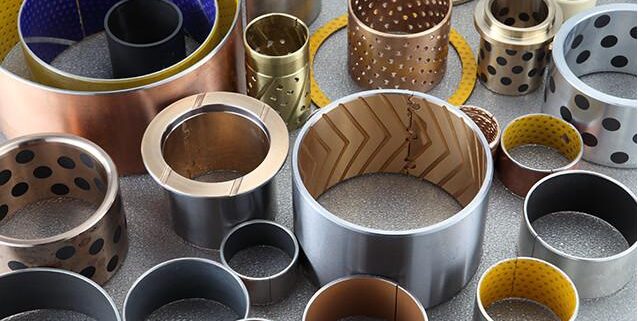
Plain bearings are the counterpart to rolling bearings. They are simpler in design and therefore more cost-effective to use. Here you can read an overview of how they are constructed, what materials and types of lubrication are available and what advantages and disadvantages they have compared to rolling bearings.
Bearings are components that guide components that move against each other. Whereas in rolling bearings the shaft is supported on rolling elements that rotate with it, in plain bearings the two components are in direct contact. This means that the shaft slides in the bearing bush or the bearing shells. This creates frictional resistance, which leads to wear. To minimise friction, there must be lubrication between the sliding surfaces.
Structure and shape of plain bearings
Plain bearings have a very simple structure because they do not contain any moving parts. The shape is usually cylindrical. They can be installed in the housing in two ways:
1. solid (design as a sliding bush).
2. split with butt joints (design as sliding shells)
The design of a plain bearing also differs according to the direction of force acting on the bearing depending on the application. There are radial bearings, i.e. supporting bearings, for radial forces and thrust bearings, i.e. track bearings, for axial forces. If the bearings have to absorb only radial forces, bushings with a cylindrical shape are sufficient.
Friction and wear
There are three types of friction in plain bearing applications:
Solid-body friction: the solids rub directly against each other. There is no lubrication. The amount of friction that occurs and the wear depend on the surface condition of the components moving against each other. There is a risk of seizure.
Liquid friction: There is no direct contact between the components. A lubricant serves as the separating medium. The amount of friction depends on the structure of the lubricant. In continuous operation, a bearing with liquid friction works practically wear-free (see hydrostatic lubrication).
Mixed friction: There are both areas of contact of the components separated by the liquid film and direct contact areas (see hydrodynamic lubrication).
Lubrication
In lubrication, a distinction is made between different lubricants and different types of lubrication:
- Oil lubrication
- Grease lubrication
- Water lubrication
- Dry lubrication
- Air and gas lubrication
Types of lubrication:
Hydrodynamic lubrication: In hydrodynamic lubrication, the lubricating film is created by movement. The lubricating oil is supplied at one point. Initially, there is mixed friction between the shaft and the bearing. With increasing rotary motion and oil supply, the pressure around the shaft is increased.
This eventually rises. Fluid friction develops. The disadvantage is that there is little pressure during start-up and run-down, so mixed friction occurs. This means that the solids are in contact, which increases friction and wear.
Hydrostatic lubrication: With hydrostatic lubrication, the oil is pressed between the sliding surfaces under high pressure. For this purpose, oil pockets in the bearing are constantly supplied with oil. The shaft and the bearing never touch each other. The lubrication conditions are ideal at any speed – even at standstill.
Permanent lubrication: Permanent lubrication ensures maintenance-free bearings. The lubricant is already introduced into the plain bearing during manufacture. This means that the bearings are soaked in lubricant. Materials are used that can absorb the lubricant well.
Plain bearing applications in industry
The plain bearing applications are huge and main are used in the industrial sector wherever they offer advantages over rolling bearings. Since they are robust and less sensitive to contamination, they are suitable for adverse environmental conditions, e.g. in the process industry, agriculture, mining, etc..
They also have advantages in applications with high speeds and high loads. Plain bearings can also be the right choice for applications where low-noise running is important or a compact, lightweight design is required – for example in automotive engineering. If very precise motion sequences are required, e.g. in machine tools, rolling bearings are the better choice.
In addition to these general characteristics, the choice of material, the type of lubrication, etc. also play a major role when it comes to the respective application. Therefore, this must be considered individually in the specific case.

